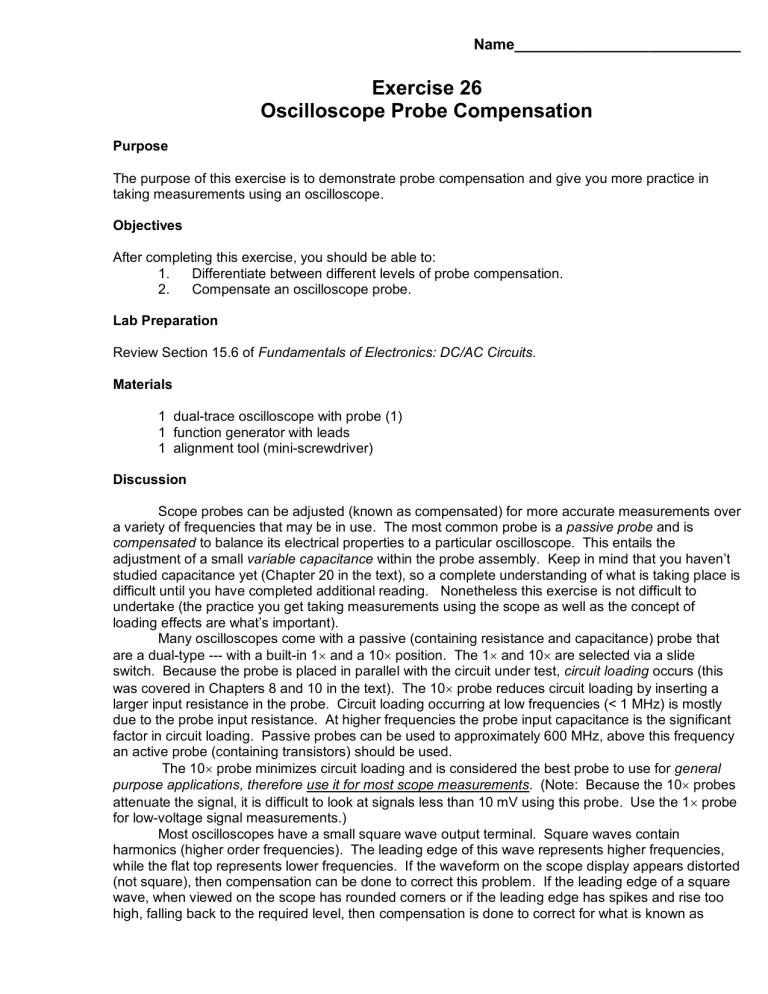Lab 26 - Mt. SAC

Name___________________________
Exercise 26
Oscilloscope Probe Compensation
Purpose
The purpose of this exercise is to demonstrate probe compensation and give you more practice in taking measurements using an oscilloscope.
Objectives
After completing this exercise, you should be able to:
1. Differentiate between different levels of probe compensation.
2. Compensate an oscilloscope probe.
Lab Preparation
Review Section 15.6 of Fundamentals of Electronics: DC/AC Circuits.
Materials
1 dual-trace oscilloscope with probe (1)
1 function generator with leads
1 alignment tool (mini-screwdriver)
Discussion
Scope probes can be adjusted (known as compensated) for more accurate measurements over a variety of frequencies that may be in use. The most common probe is a passive probe and is compensated to balance its electrical properties to a particular oscilloscope. This entails the adjustment of a small variable capacitance within the probe assembly. Keep in mind that you haven’t studied capacitance yet (Chapter 20 in the text), so a complete understanding of what is taking place is difficult until you have completed additional reading. Nonetheless this exercise is not difficult to undertake (the practice you get taking measurements using the scope as well as the concept of loading effects are what’s important).
Many oscilloscopes come with a passive (containing resistance and capacitance) probe that are a dual-type --- with a built-in 1
and a 10
position. The 1
and 10
are selected via a slide switch. Because the probe is placed in parallel with the circuit under test, circuit loading occurs (this was covered in Chapters 8 and 10 in the text). The 10
probe reduces circuit loading by inserting a larger input resistance in the probe. Circuit loading occurring at low frequencies (< 1 MHz) is mostly due to the probe input resistance. At higher frequencies the probe input capacitance is the significant factor in circuit loading. Passive probes can be used to approximately 600 MHz, above this frequency an active probe (containing transistors) should be used.
The 10
probe minimizes circuit loading and is considered the best probe to use for general purpose applications, therefore use it for most scope measurements . (Note: Because the 10
probes attenuate the signal, it is difficult to look at signals less than 10 mV using this probe. Use the 1
probe for low-voltage signal measurements.)
Most oscilloscopes have a small square wave output terminal. Square waves contain harmonics (higher order frequencies). The leading edge of this wave represents higher frequencies, while the flat top represents lower frequencies. If the waveform on the scope display appears distorted
(not square), then compensation can be done to correct this problem. If the leading edge of a square wave, when viewed on the scope has rounded corners or if the leading edge has spikes and rise too high, falling back to the required level, then compensation is done to correct for what is known as
under- or over-compensation respectively. Only when the square wave is truly 'square' is the frequency response correct and improved accuracy takes place.
You should get into the habit of compensating the probe every time you set up a scope. Figure
26.1 shows a typical probe-to-oscilloscope interface and the capacitor that is adjusted to compensate the probe.
Figure 26.1
Procedure
1. Most scopes have a special square-wave reference (1kHz, 5 Vpp) available at a terminal on the front panel that can be used as a source to compensate the probe.
2. Locate this terminal and connect the probe tip ( 10x position ) to it using CH 1. Turn the scope power on. Adjust the vertical and horizontal controls as necessary to mimic the waveforms in Figure 26.2.
3. You should see one of the three responses in Figure 26.2 for your scope probe.
Figure 26.2
4. Assuming the display is not that of a compensated probe, then using a small screwdriver, adjust the compensation screw as necessary in order to obtain a correctly compensated probe signal.
(The screw adjust may be near the BNC connector where it is attached to the scope or it may be in the probe handle.)
5. Now attach the probe tip to the output of a function generator. Select a 10 Vpp square wave output with the frequencies shown on the graticules below. Adjust the volts/div and time/div as necessary in order to display approximately 3-4 cycles of the waveform. Do not change the 10
Vpp value for any of the steps.
6. For the compensated probe, draw the waveforms and label the volts/div, Vpp and time/div values you determined as shown on the graticules below for each of the listed frequencies.
5 kHz 500 kHz 1 MHz
__________ V/DIV
__________ Vpp
__________ _s/DIV
___________ V/DIV
___________ Vpp
___________ _s/DIV
___________ V/DIV
___________ Vpp
___________ _s/DIV
7. Connect the probe tip back to the scope terminal. Now misadjust the compensation screw as necessary in order to obtain an undercompensated probe signal.
8. Repeat Steps 5-6 with the undercompensated probe.
5 kHz 500 kHz 1 MHz
___________ V/DIV
___________ Vpp
___________ _s/DIV
__________ V/DIV
__________ Vpp
__________ _s/DIV
___________ V/DIV
___________ Vpp
___________ _s/DIV
10. Connect the probe tip to the scope terminal. Now misadjust the compensation screw as necessary in order to obtain an overcompensated probe signal.
11. Repeat Steps 5-6 with the overcompensated probe.
5 kHz 500 kHz 1 MHz
__________ V/DIV
__________ Vpp
__________ _s/DIV
__________ V/DIV
__________ Vpp
__________ _s/DIV
___________ V/DIV
___________ Vpp
___________ _s/DIV
Questions
1. Compare the output signal voltage on all diagrams. Which output voltages are lower than the source?
2. Compare the output signal voltage on all diagrams. Which output voltages are higher than the source?
3. As best you can explain why the output voltages were different from the source when using the probe in an under- and over-compensated set-up.
4. Will adjusting the compensation screw on the scope probe affect the 1X setting?
5. What causes circuit loading when using a probe?
6. If a voltage measurement is being made across a high resistive circuit using a scope probe, would the 1x or 10x be a better choice? Why?
7. Why is it necessary to compensate a probe?



